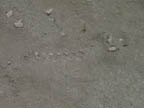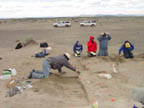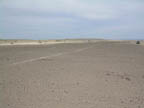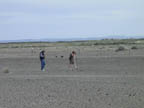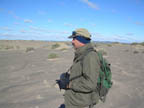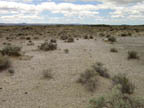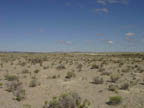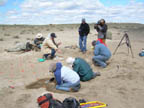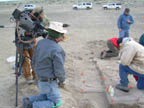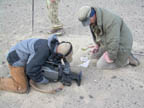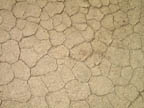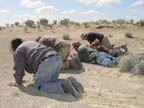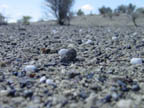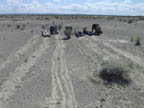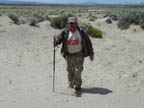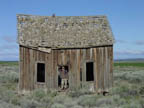Search and Rescue Report |
May, 2007 |
| Dr. James E. Martin from the South Dakota School of Mines is considered one of the foremost authorities on Fossil Lake in the country. That was why I wanted to go on this NARG trip to be able to meet him and have the opportunity to work with Dr. Martin and his graduate students. Dr. Martin has studied the stratigraphy of the lake, written extensively in scientific journals and made numerous visits to the lake since 1974. He has examined all the known lake fossils in the various museums around the country. The SD School of Mines has the largest collection of material from Fossil Lake.
Material from Fossil Lake is, on-paper, protected as it is on federal land, however because of budget limitations, signs are missing and not replaced. Areas that are not supposed to be open to vehicle traffic have very obvious tire tracks from OHV's and motorbikes. As someone mentioned, "you can't legally collect this material, but you see it get run over it with a dune buggy." We are thankful for someone like Dr. Martin who is building a collection that is an Oregon resource and preserving it for us and future generations to study. But... back to the trip. Since I was new member and this was my first field trip, Andrew Bland offered to drive, along with his brother Steven. When I acted dumb as to what to bring to eat, Andrew offered to get supplies and do the cooking. This was a smart move on my part, as we feasted on pasta, Caesar salad, made with freshly squeezed lime, home-made Avocado dip, (more freshly squeezed lime), fresh vegetable saute, etc. Definitely four-star camping! Dr. Martin and his crew were staying in the Fort Rock Guard Station bunkhouse and were gracious to let us use his showers and facilities and also offered to let us sleep on the floor in the warm bunk house as the weather was questionable. My heart lept. Not so for the Bland Bros-they set up their tent on the lawn, so I followed suit and set up my tent. Our weather was cloudy, chilly and windy. The second night the wind blew so strong that and as I lay in my newly-purchased cot, in my 20+ yr old tent, I had visions of spinning up into the air like Dorothy out of the Wizard of Oz and landing in Kansas. When I awoke--tent intact--with frost on the surface, I got out and tried to hug the Coleman stove. Andrew, in his gloves, fiddled with his fancy French press coffee maker, and turned out a brew that rivaled Starbucks. Now, I'm not a camper and after two nights of this weather, I thought Andrew and Steven would give up and move indoors. Not the Bland Bros! They just zipped open the tent windows, so the wind could move through and not blow over the tent and toughed it out. Andrew told me to zip open my windows-Ya sure, like I'm going to freeze my butt off and do that! I'd take my chances... Kansas had to be warmer. With that it then became a matter of principle--not wanting to "wimp-out" and move inside, on my actual first field trip--I thought if they could do it, so could I! The third and final night, I rounded up every piece of clean clothing I could find and put it all on (6 layers)-laid every other remaining dirty shirt, jeans, towel, and even my tent bag on top of the sleeping bag and crawled in. Ah! ...it was warm! I could survive. It was 24 degrees when I awoke. (You're probably thinking, "How could he come so unprepared!" ...Well, I made the mistake of reading last yrs account of the trip and how sunburnt everyone got, and didn't pack for cold weather) But... back to the field. Right before we arrived one of Dr. Martin's students found horse teeth in one the newer sediments (10,000 yrs) and further investigation revealed several articulated vertebrae, a femur, and upper & lower jaw. Explorations halted while all the students worked on the site. We NARG members helped in running grids on the adjoining areas. We found several fish skeletons in the upper level of the sediment and about 200 feet away Steven Bland found a zygomatic arch, which is a facial bone of a mountain lion in the same timeline-an exciting find. The second day of our trip, a crew arrived from "Oregon Field Guide", an Oregon Public Broadcasting program with Jim Newman came to film Dr. Martin and the horse site. NARG members were recruited to continue in their grid line inventory search while the cameraman scanned us going off in the horizon. When we had a couple of interesting minor discoveries, the camera zoomed in on us bending over the dirt. Andrew was wired with a microphone to record his footsteps scrunching on the sand and rock over the howling wind for the viewing audience. I was hoping that his homemade bean and salsa burritos he had the night before didn't choose to kick in their audio contributions! The following day the film crew was back for more shooting. We moved to the bird site, which is a 650,000 year old sediment, full of small bird bones, eggshell, and rodents. The preferred method of collecting this site is to assemble in a line and crawl on your belly or knees, side-by-side while you closely scan the sand, picking up bits of bone and eggshell. This makes one quite self-conscious when a cameraman is hovering over your behind as you crawl along, wondering if your butt crack is showing! Within an hour we had several different parts of birds, leg bones, sternum, rodent teeth and enough eggshell for an omelet. The highlight of the second evening was a visit from Dr. Dennis L. Jenkins, Archeologist from the University of Oregon. Dr Jenkins shared his recent discovery in the Paisley Caves --the recovery of human DNA from coprolites found in the cave, along with tools, bones and tissue of camels, horse and bison. He shared his methods of dating, which show that humans inhabited the area over 14,000 years ago. He has written an article which is currently undergoing peer review, and when it is published should create quite a bit of excitement. Both of these gentlemen were very personable, easily approachable, and willing to share their knowledge and answer your basic beginner's questions with grace and ease. We wish to extend out thanks to Dr. Martin for including NARG in his Lake investigation. Dr. Martin's passion and dedication to studying this unique repository of ancient life makes him an inspiration for any avocational paleontologist. NARG Members:Bruce Thiel, Steven Bland, and Andrew Bland. |
| ©2004 NARG - North America Research Group |


